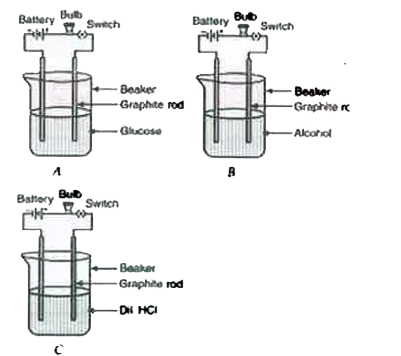Text Solution
Verified by Experts
|
Topper's Solved these Questions
ACIDS, BASES, AND SALTS
ZEN PUBLICATION|Exercise ZEN ADDITOINAL QUESTIONS SECTIONS (Long Answer Type Questions)|21 VideosView PlaylistACIDS, BASES, AND SALTS
ZEN PUBLICATION|Exercise ZEN ADDITOINAL QUESTIONS SECTIONS (Short Answer Type Questions - I)|26 VideosView PlaylistCARBON AND ITS COMPOUNDS
ZEN PUBLICATION|Exercise ACTIVITY|2 VideosView Playlist
Similar Questions
Explore conceptually related problems
Knowledge Check
Similar Questions
Explore conceptually related problems
ZEN PUBLICATION-ACIDS, BASES, AND SALTS-ZEN ADDITOINAL QUESTIONS SECTIONS (Short Answer Type Questions -II)
- State what happens when : (a) Gypsum is heated at 373 K (b) Blue c...
03:45
|
Play - "pH has a great importance in our daily life". Explain by giving three...
06:21
|
Play - Observe the following set up : (a) Which of the bulb glows ? (b...
05:10
|
Playing Now - 2 ml of NaOH solution is added to a few pieces of granulated zinc meta...
04:33
|
Play - The pH of a salt used to make tasty and cripsy pakoras is 14. Identify...
03:08
|
Play - A student adds a spoon full of powdered sodium hydrogen carbonate to a...
04:31
|
Play - You have two solutions A and B. the pH of solution A is 6 and pH of so...
04:57
|
Play - How the following substances will dissociate to produce ions in their ...
03:45
|
Play - What is tooth enamel chemically ? State the condition when it starts c...
04:30
|
Play - Answer the following : What happens when crystals of washing soda ar...
02:25
|
Play - Name the change takes place.Which two industries are based on the use ...
03:32
|
Play - With the help of balanced chemical equation, state the reaction that t...
03:16
|
Play - How is plaster of Paris chemically different from Gypsum ? How can the...
04:56
|
Play - Define olfactory indicators.
02:25
|
Play - Choose the strong acids, from the following CH(3)COOH, H(2)SO(4), H(...
01:44
|
Play - Explain the action of dilute hydrochloric acid on the following with c...
03:20
|
Play - On passing excess carbon dioxide gas through lime water, it first turn...
02:20
|
Play - A white powder is added while baking bread and cakes to make them soft...
07:16
|
Play - What will be the action of the following substances on litmus paper ? ...
04:42
|
Play - Salt A commonly used in bakery products on heating gets converted into...
03:54
|
Play
